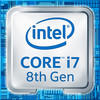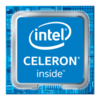Intel Core i7-8700 vs Intel Celeron 5305U vs Intel Core i7-8086K
Intel Core i7-8700
► remove from comparison
The Intel Core i7-8700 is a high-end desktop processor with six cores based on the Coffee Lake architecture and was announced in September 2017. The processor clocks at between 3.2 and 4.6 GHz and can execute up to twelve threads simultaneously thanks to Hyper-Threading. According to Intel, the CPU is manufactured in an improved 14nm (14nm++) process. Compared to the slightly higher clocked Core i7-8700K, the i7-8700 offers a lower TDP and no unlocked multiplier (no easy overclocking).
Performance
Due to the two additional cores, performance has increased by almost 50% compared to the previous quad-core Kaby Lake models. Single-core performance has not improved much. As a high-end model, the i7-8700 is suitable for the most demanding applications and games.
Graphics
The integrated Intel UHD Graphics 630 iGPU is supposed to offer higher performance as its clock rate has been increased by 50 MHz. The build is identical to that of the Intel HD Graphics 630. We do expect a performance improvement, but as a low-end solution it will probably only display current games smoothly at reduced details - if at all.
Power Consumption
Intel specifies the TDP with 65 watts. Therefore, well-dimensioned cooling systems should easily manage to deal with the created heat. We expect increased efficiency due to the higher performance.
Intel Celeron 5305U
► remove from comparison
The Intel Celeron 5305U is a low-power dual-core SoC for laptops, based on the Comet Lake architecture, which was introduced in 2020. Compared to Kaby Lake and Whiskey Lake, there are apparently no differences with Comet Lake apart from the two additional cores in the Top model Core i7-10710U. The processor is still manufactured using the mature 14nm process (14nm++ like Whiskey Lake). The processor cores clock at a fixed 2.3 GHz (no Turbo) and also only offer 2 threads (no HyperThreading). Compared to the more powerful Core i3, i5 and i7 variants, the Celeron does not offer SSE (2) support.
You can find more information about the Comet Lake architecture and the available processors on our Comet Lake topic page.
According to Intel, the integrated graphics card is called Intel UHD Graphics, but is an old Intel UHD Graphics 610. It is clocked in the Celeron 5205U at 300 - 900 MHz and is only sufficient for very demanding games. The CPU also offers an integrated DDR4-2666 / LPDDR4x 2933 / LPDDR3-2133 dual-channel memory controller as well as VP9 and H.265 video decoder and encoder.
Performance
The performance of the Celeron 5305U is in the lowest entry-level class of notebook processors in 2020. Due to the lack of Turbo and only 2 cores, the CPU cannot score points in either single-core or multi-core tasks. The processor is therefore only suitable for undemanding tasks such as surfing with a few tabs and office tasks.
The power consumption and performance can be set from 15 to 12.5 watts by the notebook manufacturer via cTDP-down. However, the processor then only runs at 800 MHz and significantly reduced performance. Even at 15 watts, however, the processor is suitable for thin and light notebooks.
Intel Core i7-8086K
► remove from comparison
The Intel Core i7-8086K is a high-end desktop processor with six cores based on the Coffee Lake architecture and was announced in mid 2018. It is a limited edition for the 40 year X86 anniversary and at the time of announcement the fastest Coffee-Lake CPU. The processor clocks at between 3.7 and 5 GHz and can execute up to twelve threads simultaneously thanks to Hyper-Threading. According to Intel, the CPU is manufactured in an improved 14nm (14nm++) process. The i7-8086K is comparatively easy to overclock thanks to the unlocked multiplier. Compared to the cheaper i7-8700K (-66 Dollars) only the single core Turbo clock speed is faster (5 GHz versus 4.7 GHz).
Performance
Due to the two additional cores, performance has increased by almost 50% compared to the Core i7-7700K when all cores are in use. Compared to the cheaper Core i7-8700K, the 8086K offers only a higher single core Turbo Boost and therefore in daily usage and gaming not faster. As a high-end model, the i7-8086K is suitable for the most demanding applications and games.
Graphics
The integrated Intel UHD Graphics 630 iGPU is supposed to offer higher performance as its clock rate has been increased by 50 MHz. The build is identical to that of the Intel HD Graphics 630. We do expect a performance improvement, but as a low-end solution it will probably only display current games smoothly at reduced details - if at all.
Power Consumption
Intel specifies the TDP with 95 watts. Therefore, well-dimensioned cooling systems should easily manage to deal with the created heat. We expect increased efficiency due to the higher performance.
| Model | Intel Core i7-8700 | Intel Celeron 5305U | Intel Core i7-8086K | ||||||||||||||||||||||||||||||||||||||||||||||||||||||||||||||||||||||||||||||||||||||||||||||||
| Codename | Coffee Lake-S | Comet Lake-U | Coffee Lake-S | ||||||||||||||||||||||||||||||||||||||||||||||||||||||||||||||||||||||||||||||||||||||||||||||||
| Series | Intel Coffee Lake | Intel Comet Lake | Intel Coffee Lake | ||||||||||||||||||||||||||||||||||||||||||||||||||||||||||||||||||||||||||||||||||||||||||||||||
| Series: Coffee Lake Coffee Lake-S |
|
|
| ||||||||||||||||||||||||||||||||||||||||||||||||||||||||||||||||||||||||||||||||||||||||||||||||
| Clock | 3200 - 4600 MHz | 2300 MHz | 3700 - 5000 MHz | ||||||||||||||||||||||||||||||||||||||||||||||||||||||||||||||||||||||||||||||||||||||||||||||||
| L1 Cache | 384 KB | 384 KB | |||||||||||||||||||||||||||||||||||||||||||||||||||||||||||||||||||||||||||||||||||||||||||||||||
| L2 Cache | 1.5 MB | 1.5 MB | |||||||||||||||||||||||||||||||||||||||||||||||||||||||||||||||||||||||||||||||||||||||||||||||||
| L3 Cache | 12 MB | 12 MB | |||||||||||||||||||||||||||||||||||||||||||||||||||||||||||||||||||||||||||||||||||||||||||||||||
| Cores / Threads | 6 / 12 | 2 / 2 | 6 / 12 | ||||||||||||||||||||||||||||||||||||||||||||||||||||||||||||||||||||||||||||||||||||||||||||||||
| TDP | 65 Watt | 15 Watt | 95 Watt | ||||||||||||||||||||||||||||||||||||||||||||||||||||||||||||||||||||||||||||||||||||||||||||||||
| Technology | 14 nm | 14 nm | 14 nm | ||||||||||||||||||||||||||||||||||||||||||||||||||||||||||||||||||||||||||||||||||||||||||||||||
| Socket | FCLGA1151 | BGA1528 | FCLGA1151 | ||||||||||||||||||||||||||||||||||||||||||||||||||||||||||||||||||||||||||||||||||||||||||||||||
| Features | Dual-Channel DDR3(L)-1600/DDR4-2666 Memory Controller, HyperThreading, AVX, AVX2, AES-NI, TSX-NI, Quick Sync, Virtualization, vPro | LPDDR3-2133/DDR4-2400 RAM, PCIe 2, 4 GT/s bus, MMX, SSE, SSE2, SSE3, SSSE3, SSE4.1, SSE4.2, AVX, AVX2, BMI2, ABM, FMA, ADX, VMX, SMEP, SMAP, MPX, EIST, TM1, TM2, SST, AES-NI, RDRAND, RDSEED, SGX | Dual-Channel DDR3(L)-1600/DDR4-2666 Memory Controller, HyperThreading, AVX, AVX2, AES-NI, TSX-NI, Quick Sync, Virtualization, vPro | ||||||||||||||||||||||||||||||||||||||||||||||||||||||||||||||||||||||||||||||||||||||||||||||||
| iGPU | Intel UHD Graphics 630 (350 - 1200 MHz) | Intel UHD Graphics 610 (300 - 900 MHz) | Intel UHD Graphics 630 (350 - 1200 MHz) | ||||||||||||||||||||||||||||||||||||||||||||||||||||||||||||||||||||||||||||||||||||||||||||||||
| Architecture | x86 | x86 | x86 | ||||||||||||||||||||||||||||||||||||||||||||||||||||||||||||||||||||||||||||||||||||||||||||||||
| Announced | |||||||||||||||||||||||||||||||||||||||||||||||||||||||||||||||||||||||||||||||||||||||||||||||||||
| Manufacturer | ark.intel.com | ark.intel.com | ark.intel.com | ||||||||||||||||||||||||||||||||||||||||||||||||||||||||||||||||||||||||||||||||||||||||||||||||
| max. Temp. | 100 °C | 100 °C | |||||||||||||||||||||||||||||||||||||||||||||||||||||||||||||||||||||||||||||||||||||||||||||||||
| $107 U.S. | $425 U.S. |
Benchmarks
Average Benchmarks Intel Core i7-8700 → 0% n=0
Average Benchmarks Intel Celeron 5305U → 0% n=0
Average Benchmarks Intel Core i7-8086K → 0% n=0
* Smaller numbers mean a higher performance
1 This benchmark is not used for the average calculation













